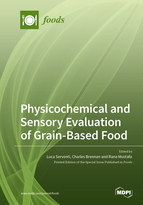Physicochemical and Sensory Evaluation of Grain-Based Food
A special issue of Foods (ISSN 2304-8158). This special issue belongs to the section "Grain".
Deadline for manuscript submissions: closed (25 February 2022) | Viewed by 60848
Special Issue Editors
Interests: product development; physicochemical properties of food; food chemistry; hydrocolloids; enzymes; plant-based nutrition; legumes; upcycling; Aquafaba; Liluva
Interests: polysaccharide utilization; glycemic response; dietary fibre; food structure and function
Special Issues, Collections and Topics in MDPI journals
Interests: value-added processing; plant-based egg substitute; food product development; process development and optimization; enzymatic oxidation of phenolic compounds; enzymatic browning
Special Issue Information
Dear Colleagues,
Consumers are increasingly demanding more sources of plant-based nutrition, and the food industry is responding by developing novel foods with grain-based ingredients. These products include dairy, egg and meat alternatives. Notably, in order for the production of these foods to be viable, the sustainability of the supply chain must improve and the product price must be lowered. Therefore, upcycling of grains by-products has been considered. However, the functionality and acceptability of functional foods made with upcycled ingredients from legumes and grains must be tested to ensure consumer compliance. This Special Issue of Foods aims to present the latest research on the physicochemical and sensory evaluation of plant-based alternatives to dairy, eggs and meat made with grains. Product categories include beverages, fermented beverages, dressings, bakery items and plant-based meats. Ingredients considered include, but are not limited to, protein concentrates and isolates, fibres, starches and enzymes. Particular emphasis will be given to potential applications of upcycled ingredients such as legume water (Aquafaba, Liluva), okara, spent grains and by-products of the starch industry (protein, fibre) and protein isolation (starches). Physicochemical evaluation encompasses determination of the functionality of ingredients (foaming, emulsifying and thickening), texture analysis, rheology (viscosity, pasting properties), thermal properties (thermogravimetric analysis and differential scanning calorimetry), water mobility (nuclear magnetic resonance) and image analysis. Sensory evaluation includes both trained panels and consumer preference.
Kind regards,
Dr. Luca ServentiProf. Dr. Charles Brennan
Dr. Rana Mustafa
Guest Editors
Manuscript Submission Information
Manuscripts should be submitted online at www.mdpi.com by registering and logging in to this website. Once you are registered, click here to go to the submission form. Manuscripts can be submitted until the deadline. All submissions that pass pre-check are peer-reviewed. Accepted papers will be published continuously in the journal (as soon as accepted) and will be listed together on the special issue website. Research articles, review articles as well as short communications are invited. For planned papers, a title and short abstract (about 100 words) can be sent to the Editorial Office for announcement on this website.
Submitted manuscripts should not have been published previously, nor be under consideration for publication elsewhere (except conference proceedings papers). All manuscripts are thoroughly refereed through a single-blind peer-review process. A guide for authors and other relevant information for submission of manuscripts is available on the Instructions for Authors page. Foods is an international peer-reviewed open access semimonthly journal published by MDPI.
Please visit the Instructions for Authors page before submitting a manuscript. The Article Processing Charge (APC) for publication in this open access journal is 2900 CHF (Swiss Francs). Submitted papers should be well formatted and use good English. Authors may use MDPI's English editing service prior to publication or during author revisions.
Keywords
- cereals
- legumes
- dairy alternatives
- egg alternatives
- meat alternatives
- hydrocolloids
- enzymes
- physicochemical properties
- sensory analysis
- upcycling









